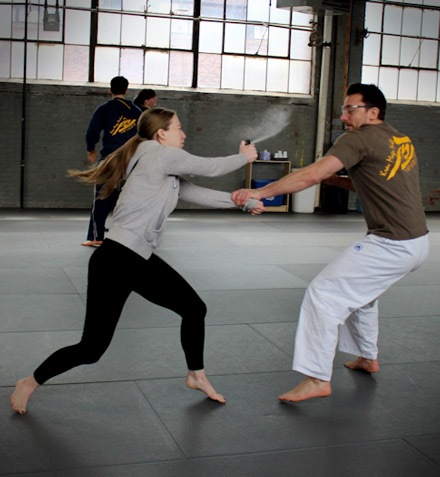Women's Self-Defense

Articles On Women's Self-Defense
- Campus Safety (Part One)
- Campus Safety (Part Two)
- Dads Dont Know
- Dating Advice
- Female Sexual Assailants
- Realistic Depictions: Women's Self Defense
- Saving Face - Conversations About Date Rape
- The Men Should Just Stop Raping Women Argument
- What Were You Wearing?
- Why Rapes Don't Get Reported
- Women's Self Defense - The Same Tired Old Story
- Women's Self Defense
- Rape As A War Crime
- Date Rape Drugs
- Scavengers
All Self-Defense Articles
Women's Self-Defense & Personal Safety
Women’s self-defense programs have a tendency to focus on threats and attacks that are sexually motivated, such as rape. However, it would be wrong to think that these are the only types of dangers that modern women face. Although, women are predominantly attacked and threated by men, they may also face assaults from other women e.g., drunk, jealous partners will sometimes act aggressively and violently to other women they see their partner talking to in bar and club settings etc. This means that self-defense for women has to include teaching solutions to these types of scenarios as well. Also, there should be an acknowledgment of the limits of “self-defense” teaching and training for women who are being victimized by violent intimate partners (IPV – Intimate Partner Violence). Teaching physical solutions to attacks in these complex relationships, could see women putting themselves in greater danger(s). A self-defense instructor/teacher should recognize that this population needs specific and unique help, information, and assistance from those who are qualified to help individuals in these situations to successfully navigate their way to safety etc. The law recognizes that “self-defense” in violently abusive relationship is somewhat different to that which occurs in public settings, where there is no prior relationship between the parties involved etc. Where, those with the appropriate knowledge and training may be of assistance is in helping women to identify the warning signs that may indicate that a relationship could turn abusive – either physically, emotionally and/or psychologically etc. – before it does.
Women’s self-defense, though empowering, should not be equated with empowerment training. Not every situation is preventable and solvable by shouting at an aggressor to “get back!” etc. Whilst there is a role for such explicit boundary setting, solutions to violence should not be distilled down into a singular response for dealing with all scenarios etc. When dealing with aggressive and violent individuals, situations should determine solutions and not the other way round. There is rarely a one-size-fits-all-approach that can be applied to real-life violence. There are the times when it is necessary to de-escalate and resolve a conflict, through being effective rather than being/enforcing a “right”. Learning how to correctly interpret a situation and fashion a suitable response whether it is physical or non-physical is at the heart of any self-defense system.
Whilst there is a need for cultural shifts around the way that women are seen and treated within society, when it comes to safety, women’s self-defense training is still seen/viewed as the most effective means of dealing with violence against women. If you are interested in our Boston based, free women’s self-defense program please click here, or if you are looking to bring our training to your organization please click here (we can deliver our self-defense training both virtually and in-person).
References
Brecklin, L. R. (2008). Evaluation outcomes of self-defense training for women: A review. Aggression and Violent Behavior, 13(1), pp. 60-76.
Hollander, J. A. (2018). Women's self‐defense and sexual assault resistance: The state of the field. Sociology Compass, 12(8).
Belknap, J., Larson, D. L., Abrams, M. L., Garcia, C., & Anderson-Block, K. (2012). Types of intimate partner homicides committed by women: Self-defense, proxy/retaliation, and sexual proprietariness. Homicide Studies, 16(4), pp. 359-379.